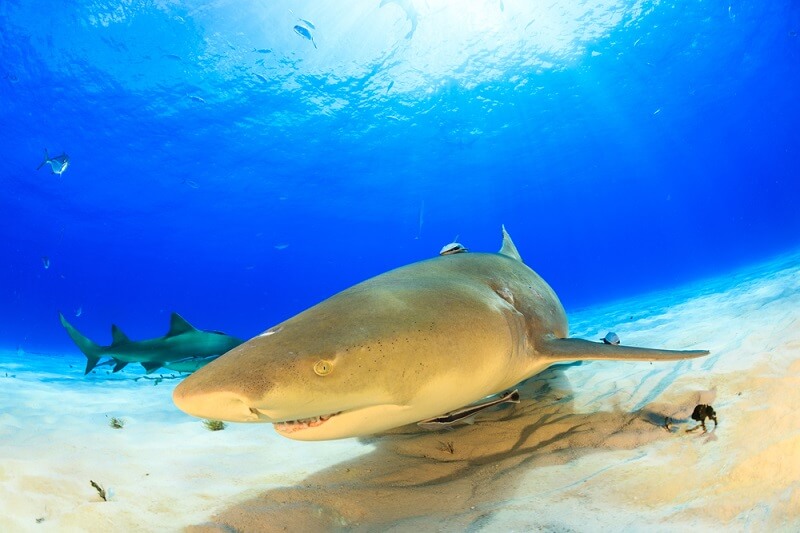
| Kingdom | Animalia |
| Phylum | Chordata |
| Class | Chondrichthyes |
| Order | Carcharhiniformes |
| Family | Carcharhinidae |
| Genus | Negaprion |
| Species | Negaprion brevirostris |
| Niche | Marine Piscivore (Fish Predator) |
| Length | 7.9-10.2 ft (2.4-3.1 m) |
| Weight | Up to 400 lbs (184 kg) |
| Lifespan | Unknown, but well over 30 years |
| Social Structure | Gregarious, spending time in loose associations with other lemon sharks |
| Conservation Status | Near Threatened |
| Preferred Habitat | Near-shore marine habitats |
| Average Litter Size | Several pups per litter |
| Main Prey Species | Fish, though occasionally crustaceans and benthic organisms |
| Predators | Larger fish (as juveniles), humans |
The Basics
The lemon shark is a medium-sized shark species that is native to the western coast of Africa, as well as the Atlantic and Pacific coasts of North and South America. The lemon shark is a nocturnal predator, feeding on fish cooperatively in small groups. The shark gets its name from its slightly yellow coloration, which helps it camouflage into the sandy bottom of shallow coastlines.
Lemon sharks are viviparous, meaning they give birth to live young after a period of gestation. The young, less than a foot long, are often birthed near mangroves. The branched root system of mangrove shorelines allows the young sharks to grow without the immediate threat of predation and gives them access to plenty of food in the form of other small fish that use the mangroves as a nursery. Once lemon sharks are large enough, they will venture out into deeper waters.
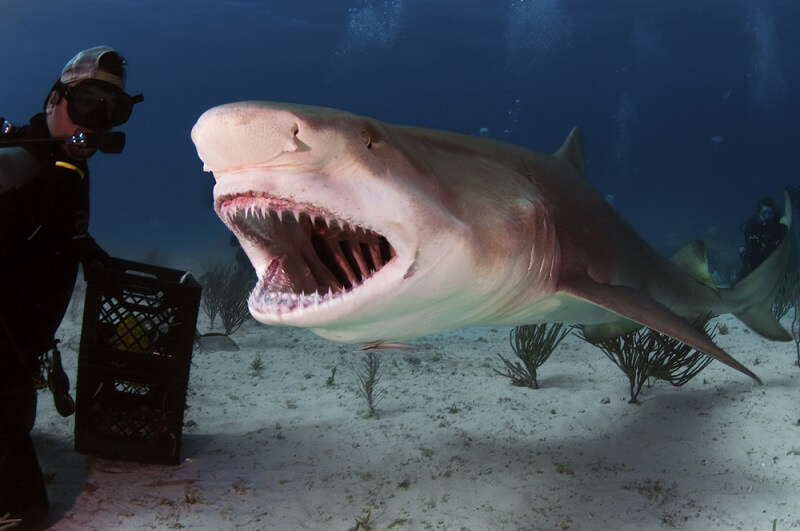
Typically, lemon sharks hunt gregariously. Small groups of lemon sharks scour coral reefs at nighttime. When one shark scares up a sleeping fish, other lemon sharks are there to grab it. Like other sharks, a feeding frenzy usually occurs when blood is released into the water from a kill. This can draw many lemon sharks at once – which quickly devour any prey that was caught by the first shark. While this gives each shark less of the total meal, the group is much more efficient at catching prey together and therefore the entire group benefits!
While lemon sharks have bitten people, they are not a particularly aggressive shark and most bites are made accidentally during feeding frenzies that divers get too close to. Unfortunately, humans pose more of a threat to lemon sharks because of the rapid destruction of mangrove coastlines that protect baby lemon sharks from larger predators. The lemon shark is classified as Near Threatened, due largely to the destruction of mangrove habitat and the destructive practice of shark finning.
Interesting Insights from the Lemon Shark!
Lemon sharks may have a sour name, but they sure provide some sweet opportunities to learn about important biological concepts. They are great representative species for a number of important topics that tie many different species together in biology.
Shark Finning
A commonly held belief in several cultures is that shark fins can provide a curative effect for several diseases when eaten in a soup – shark fin soup.
To harvest shark fins for this soup, shark species around the world are being harvested at unprecedented and unsustainable rates. The worst part is that only the fins of a shark are valuable. Sharks are typically caught with traditional fishing gear or long lines, reeled in, and their fins are cut off. Still alive but bleeding out, the sharks are dumped back into the water. Without the ability to swim, the sharks cannot get oxygen through their gills and suffocate.
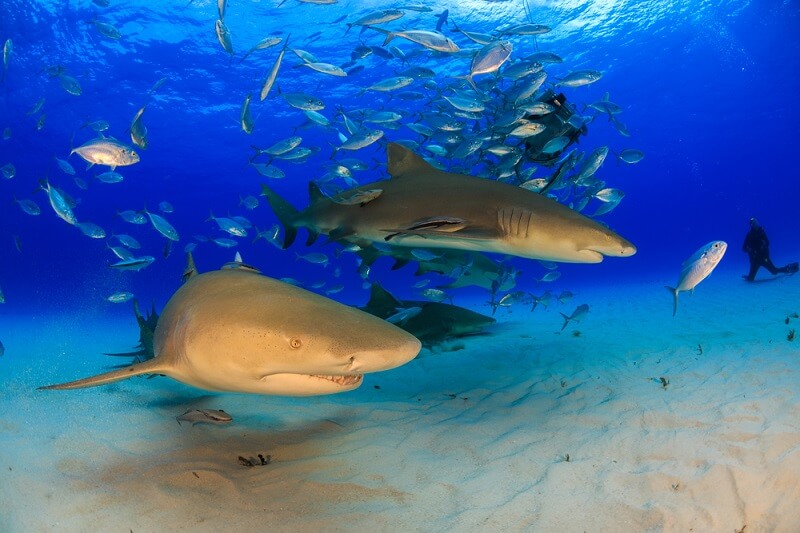
While shark fin soup is considered a delicacy in many countries, its beneficial effects have never been proven in a scientific study. Further, there is a large body of evidence that suggests apex predators should never be consumed because of bioaccumulation – the fact that toxins build up through the trophic levels and can cause sickness if we try to consume those species.
Mangrove Nurseries
Like many other fish species, baby lemon sharks are highly vulnerable to predators. Luckily, there is a perfect marine environment for developing sharks. Mangroves are a type of plant that grows along the edge of the ocean, along coastlines and around islands. The roots of the mangrove trees grow into complex patterns, creating a barrier of protection against predators that are too large to move through the branches.
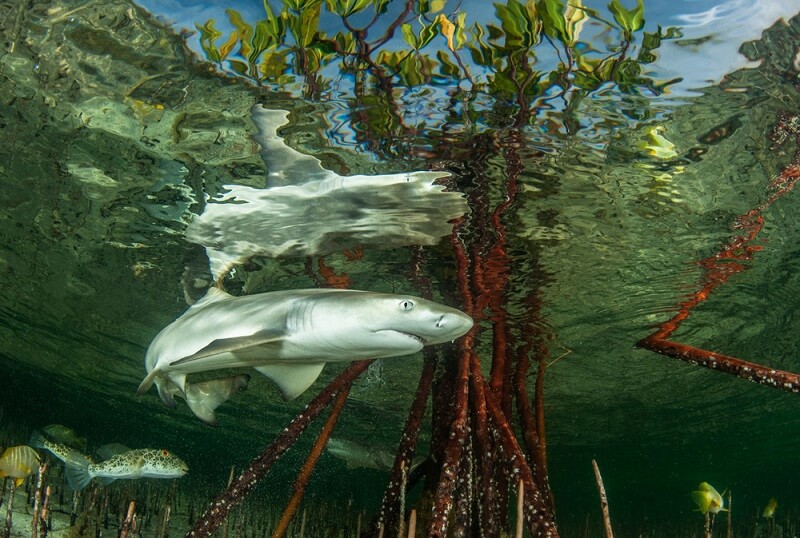
Mangroves are essentially microenvironments of the larger ocean ecosystem. Many different species, from algae-eating fish to massive sharks, get their start in the microcosm of the mangroves. Essentially, since all the organisms are smaller versions of their adult counterparts, the ecology of mangroves is a miniature version of the ecology of the ocean. Baby lemon sharks many spend several years hunting within mangrove shorelines before they are big enough to venture out into the ocean.
Apex Predators as Ecological Indicators
Lemon sharks are apex predators when they are fully grown. Essentially, this means that they are at the top of the food web. Since the food web transfers only a portion of energy from lower trophic levels to higher ones, simply counting the number of apex predators can tell an ecologist how many organisms are in the trophic levels below it. The lemon shark is known to be a key indicator species for marine environments.
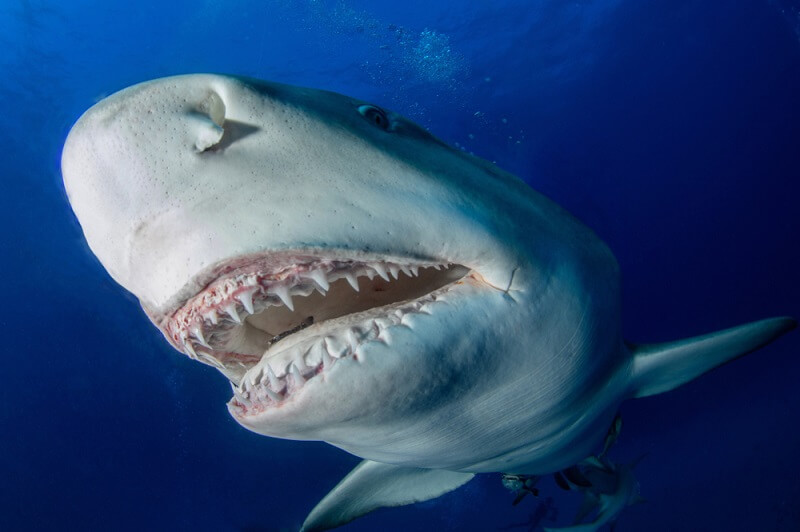
If lemon shark numbers start to decline, it is a very dangerous sign for the rest of the ecosystem. The loss of even one lemon shark means that the trophic levels below the top may be losing tens, hundreds, or even thousands of smaller organisms. Oftentimes, this decline is caused almost solely by the loss of mangrove coastline – one of the most important nurseries in the entire marine ecosystem. On the other hand, lemon shark population increase is a sign that the entire ecosystem is healthy and productive.
